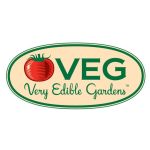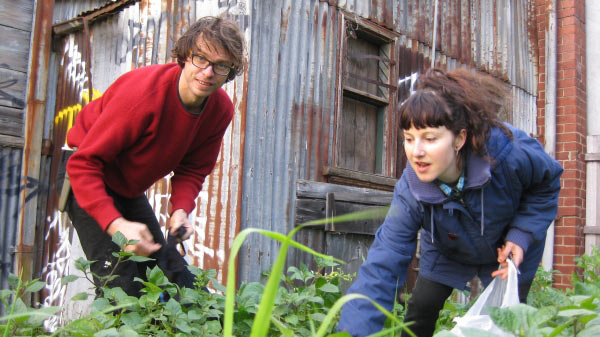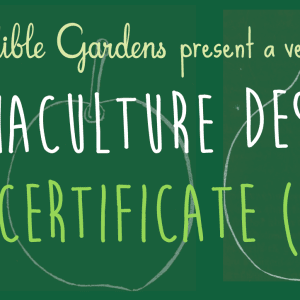By Dan Palmer, Very Edible Gardens
Earlier this year we hung out with David Holmgren for a day. Toward the end of the day David made a passing comment that stayed with me. To paraphrase, he said something like “we can get a bit carried away with growing fruit and vegetables when the bulk of our calories continue to come from grains, meat & dairy.” The implication was that if we don’t tune in to this reality and ways we can obtain these calories sustainably (or better than sustainably), then we are missing something very, very important. Fruit and vegetables add important vitamins and minerals to our diet, but very few if any of us live on fruit and vegetables alone.
Most of us, whether carnivores, omnivores, vegetarians or vegans, obtain the bulk of the energy and protein than sustains us from a particular type of plant: The annual crop.
Annual plants have a life cycle of a year or less, meaning they stick around for a single growing season then have to start from scratch (i.e., from seed) the following year year.
Corn, wheat, rye, oats, barley, rice & sorghum are all annual crops (which happen to all be grasses) that between them likely provide the bulk of calories for the bulk of people on the planet. Most and probably all industrial meat and dairy come from animals fed annual plants (mostly grass) or the products of annual plants (mostly grain). Add soybeans, millet and a few other annual crops and you have the bulk of the global human food supply sewn up.
So what’s the big deal? In his recent book Restoration Agriculture, Mark Shepard tells us what the big deal is (in no uncertain terms):

“Every human society that has relied on annual crops as staple foods in their diet has collapsed. Every single one. Every human society from the temperate zone to the tropics that has relied on annuals to feed itself, is now gone. And the rich, abundant ecosystems where their temporary societies once flourished have been rendered into dust” (p. xix)
What the?!?! You started reading an article about the quirky concept of eating acorns for breakfast and now you’re being told that unless we obtain our bulk calories from something other than annual crops we are going to be rendered into dust? Yes, well, sorry about that. But you can hardly stop now right? Let us continue. We’ll get to the acorn eating soon, I promise.
The reason annual-crop dependent cultures collapse is that annual crops require bare soil to grow in each year. For Nature, bare soil is a wound to heal. Healing means covering the wound, so she throws the plants we call weeds at it and will do so as long as she lives. This means that preparing the ground to replant an annual crop requires ploughing or spraying herbicide to kill weeds (or whatever plants are there before we start cropping it – Amazonian rainforest for example). Ploughing and spraying herbicide harms the soil directly, but more importantly creates bare soil. Bare soil is exposed to the elements of sun, wind & rain, which dry, blow and wash it away. Eventually no more soil. Eventually no more us.
Let us recap:
1. We humans are currently dependent for our sustenance on the products of annual plants and the products of animals sustained on the products on annual plants.
2. The cropping of annuals on a large scale requires practices that destroy soil.
3. Any practice that both depends on and destroys soil is a temporary practice.
4. The agriculture that currently sustains humanity is such a practice i.e., we are currently feeding ourselves in a way that will at some point collapse.
Right. Good. Let us move on to consider a magnificent alternative to our addiction to annual plants, and to collapsing, and to being rendered into dust. I’ve got your attention now, haven’t I!
Enter the perennial plant, which, get this, keeps on living. Many perennial plants produce calories that can sustain humans year after year after year, in some cases for thousands of years, with, that’s right, no bare earth required.
This is good news! If we can sustain ourselves without having to bare the earth, then we can sustain ourselves without having to destroy the earth. Not that we will go into it here, but we can sustain ourselves whilst actually improving ecosystem health.
Perennial plants include trees and woody shrubs as well as many grasses and other small herbaceous or non-woody plants. In established, diverse and healthy ecosystems perennial plants are dominant. Sure, annuals are usually in the mix, ready to help patch up any bare earth that crops up, but to take a punt we’re talking 10, maybe 20 percent tops. They are fringe dwellers, opportunists, temporary placeholders toward to a better and more perennial place.
So let’s get into specifics here, what are some of these perennial plants that might just save our skins, what bits do we eat, and most importantly, what do they taste like?
I know, I know, how could I do this to you when it was just getting interesting, but you’ll just have to read part two for all this and more.



